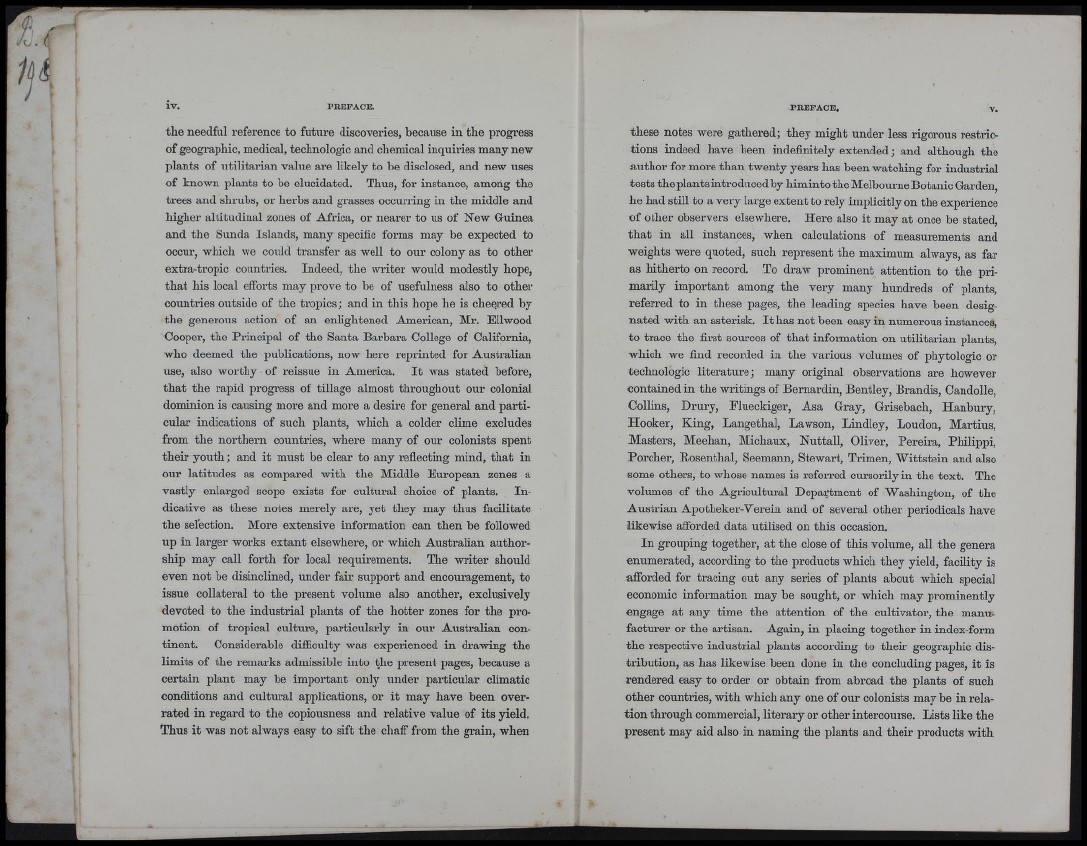
IV. PREFACE.
the needful reference to future discoveries, because in the progress
of geographic, medical, technologic and chemical inquiries many new
plants of utilitarian value are likely to be disclosed, and new uses
of known plants to be elucidated. Thus, for instance, among the
trees and shrubs, or herbs and grasses occurring in the middle and
higher altitudinal zones of Africa, or nearer to us of New Guinea
and the Sunda Islands, many specific forms may be expected to
occur, which we could transfer as well to our colony as to other
extra-tropic countries. Indeed, the writer would modestly hope,
th a t his local efibrts may prove to be of usefulness also to other
countries outside of the tropics; and in this hope he is cheered by
the generous action of an enlightened American, Mr. Ellwood
Cooper, the Principal of the Santa Barbara College of California,
who deemed the publications, now here reprinted for Australian
use, also worthy of reissue in America. I t was stated before,
th a t the rapid progress of tillage almost throughout our colonial
dominion is causing more and more a desire for general and particular
indications of such plants, which a colder cKme excludes
from the northern countries, where many of our colonists spent
their youth; and it must be clear to any reflecting mind, th a t in
our latitudes as compared with the Middle European zones a
vastly enlarged scope exists for cultural choice of plants. In dicative
as these notes merely are, yet they may thus facilitate
the selection. More extensive information can then be followed
up in larger works extant elsewhere, or which Australian authorship
may call forth for local requirements. The writer should
even not be disinclined, under fair support and encouragement, to
issue collateral to the present volume also another, exclusively
devoted to the industrial plants of the hotter zones for the promotion
of tropical culture, particularly in our Australian continent.
Considerable difficulty was experienced in drawing the
limits of the remarks admissible into the present pages, because a
certain plant may be important only under particular climatic
conditions and cultural applications, or it may have been overrated
in regard to the copiousness and relative value of its yield.
Thus it was not always easy to sift the chaff from the grain, when
PREFACE. V.
these notes were gathered; they might under less rigorous restrictions
indeed have been indefinitely extended; and although the
author for more than twenty years has been watching for industrial
tests the plants introduced by him into the Melbourne Botanic Garden,
he had still to a very large extent to rely implicitly on the experience
of other observers elsewhere. Here also it may at once be stated,
th a t in all instances, when calculations of measurements and
weights were quoted, such represent the maximum always, as far
as hitherto on record. To draw prominent attention to the primarily
important among the very many hundreds of plants,
referred to in these pages, the leading species have been designated
with an asterisk. I t has not been easy in numerous instances,
to trace the first sources of that information on utilitarian plants,
which we find recorded in the various volumes of phytologic or
technologic literature; many original observations are however
contained in the writings of Bernardin, Bentley, Brandis, Candolle,
Collins, Drury, Elueckiger, Asa Gray, Grisebach, Hanbury,
Hooker, King, Langethal, Lawson, Bindley, Loudon, Martins,
Masters, Meehan, Michaux, Nuttall, Oliver, Pereira, Philippi,
Porcher, Bosenthal, Seemann, Stewart, Trimen, Wittstein and also
some others, to whose names is refeiTed cursorily in the text. The
volumes of the Agricultural Department of Washington, of the
Austrian Apotheker-Verein and of several other periodicals have
likewise afforded data utilised on this occasion.
In grouping together, at the close of this volume, all the genera
enumerated, according to the products which they yield, facility is
afforded for tracing out any series of plants about which special
economic information may be sought, or which may prominently
engage at any time the attention of the cultivator, the manufacturer
or the artisan. Again, in placing together in index-form
the respective industrial plants according to their geographic distribution,
as has likewise been done in the concluding pages, it is
rendered easy to order or obtain from abroad the plants of such
other countries, with which any one of our colonists may be in relation
through commercial, literary or other intercourse. Lists like the
present may aid also in naming the plants and their products with